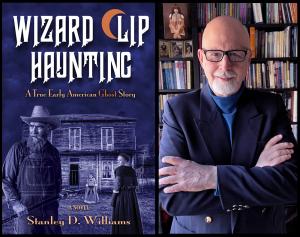Fr. Demetrius Gallitzin, founder of Loretto and eyewitness to the Wizard Clip hauntings is the telling force behind the novel that took 10 years to complete.
In 2014 Williams spent a day in Loretto with Gallitzin’s postulator for sainthood, Mrs. Betty Seymour, learning about Gallitzin, a once Russian prince. Gallitzin, who was known by his parishioners simply as Fr. Smith, became the first Catholic priest to complete all of his training and be ordained in the newly formed U.S. diocese under then Bishop John Carroll. Gallitzin wrote extensively about his involvement in the Wizard Clip affair but his writings were lost to history. Discovering Gallitzin’s involvement, Williams appropriated the once Russian Prince and horseman, to narrate what one reviewer called a “spine chilling masterpiece.”
The multifaceted tale chronicles the many lives and vulnerable families that became unwittingly involved in the “gripping” tale of human versus demonic entities. Reviewers have called the epic literary work: “Riveting!”... “Captivating,”... “A Cliff-Hanging Faith-Builder,”... and “Worth Every Minute of Reading.”
Williams, a respected Hollywood script consultant based on his story-structure book, “The Moral Premise: Harnessing Virtue and Vice for Box Office Success,” has worked with Will Smith on multiple projects. Smith calls Williams Moral Premise book, “the most important tool in my new tool box.” Williams will take time during his visit at SFU to visit classrooms and talk with students and faculty about the craft of storytelling, writing, and the twists and turns of his historical research.
The Wizard Clip Haunting book tour schedule can be found at the top of the book’s website. The novel’s historic perspective on Catholicism in the late 18th century has triggered a “History of the Catholic Faith in the Americas Conference” planned for the evening of Oct 17, and then all day on December 9, 2023. Both conference events will be held at Priest Field Pastoral Center in Middleway, West Virginia.
While a work of historical fiction, a great many of the characters and events in Wizard Clip Haunting are real. Along with Fr. Gallitzin, the main characters— Adam and Mary Ann Livingston, their neighbors Richard and Anastasia McSherry, and Fr. Denis Cahill actually lived through the hauntings. It was at the request of Bishop John Carroll that the events were investigated by Gallitzin, who has come to be known as the Apostle of the Alleghenies, and is under consideration for canonization by the Catholic Church; his current status is “Servant of God.”
During his life time, Fr. Gallitzin wrote of the Wizard Clip hauntings: “After three months of investigation, I was soon converted to a full belief of them. No lawyer in a court of justice did more than I, nor procured more than your unworthy servant.”
The story Gallitzin tells in the novel is not one but four, woven into a colorful, and at times tragic tapestry of American history along with real and fictional characters. The first story involves a 35-acre plot of land that becomes the site of a deranged murder, a forged land deed, and a curse that results in its ownership being contested for a 100 years. Today, the plot of land fulfills Adam Livingston’s wish that it be used for the care and feeding of a Catholic priest. It is the Priest Field Pastoral Center in Middleway, West Virginia.
The second story involves Adam Livingston and his family who are forced to deal not only with the hauntings, but their own imperfections that lead first to disturbing, and then to catastrophic consequences.
The third story is that of a heroic but renegade Irish priest, Fr. Denis Cahill. Having escaped anti-Catholic Ireland and finding his way to the Early United States by a circuitous but necessary route, he founds six parishes before there’s even a bishop to oversee them or their itinerant priest. The rebel cleric falls out with America’s first bishop John Carroll, in part over the haunting events at Livingston’s farm. But the residual anti-cleric sentiment left from England’s penal laws, bring Cahill often close to death, to say nothing of a particularly attractive Irish siren, Leticia.
The fourth story is the source of the now famous hauntings, a persistent demonic poltergeist with a real name. Commonly known as the Clipping Wizard for its proclivity of cutting crescent moons from cloth, the demon does not hesitate to lash out with vengeance when its existence is threatened by the presence of Christian ministers who have come to exorcise it.
Today, 226 years later, the village of Middleway, West Virginia continues to celebrate its place in history with wood badges on building fronts depicting a crescent moon, a pair of scissors, and a magician in a top hat. The village, to some, is still remembered as Clip Town.
Stanley David Williams
Nineveh's Crossing
+1 248-344-4423
email us here
Visit us on social media:
Facebook
Twitter
LinkedIn
Instagram
YouTube
TikTok





